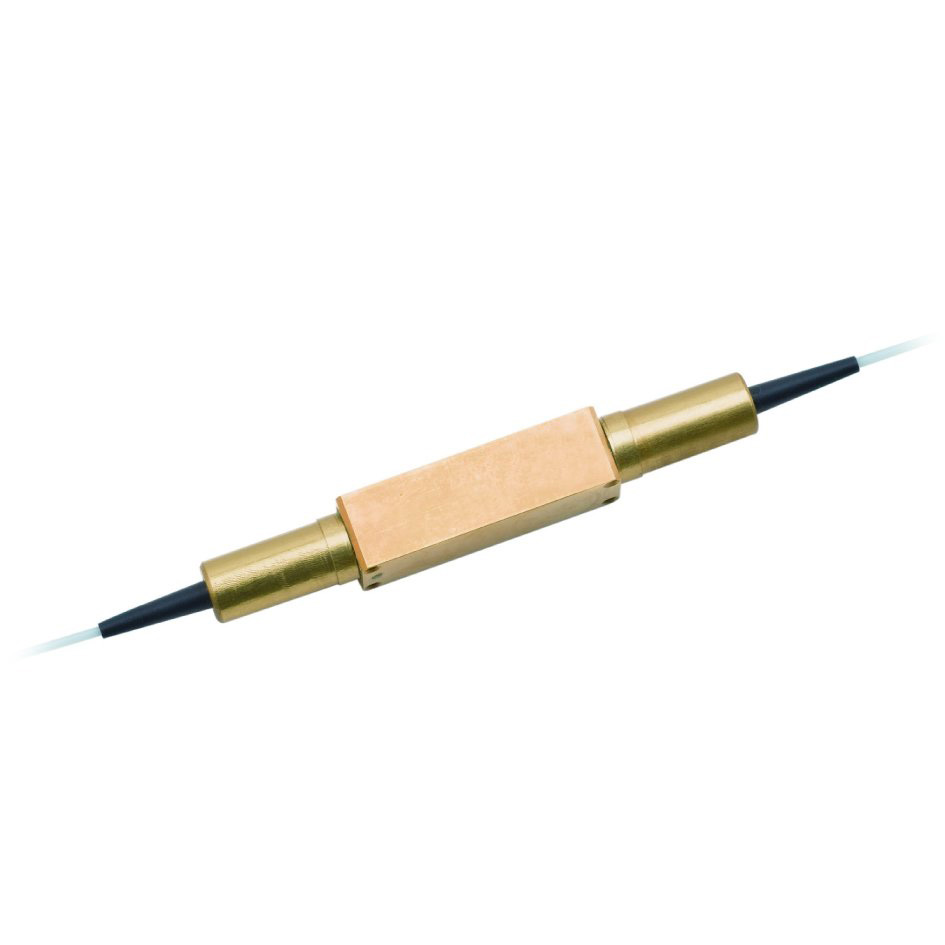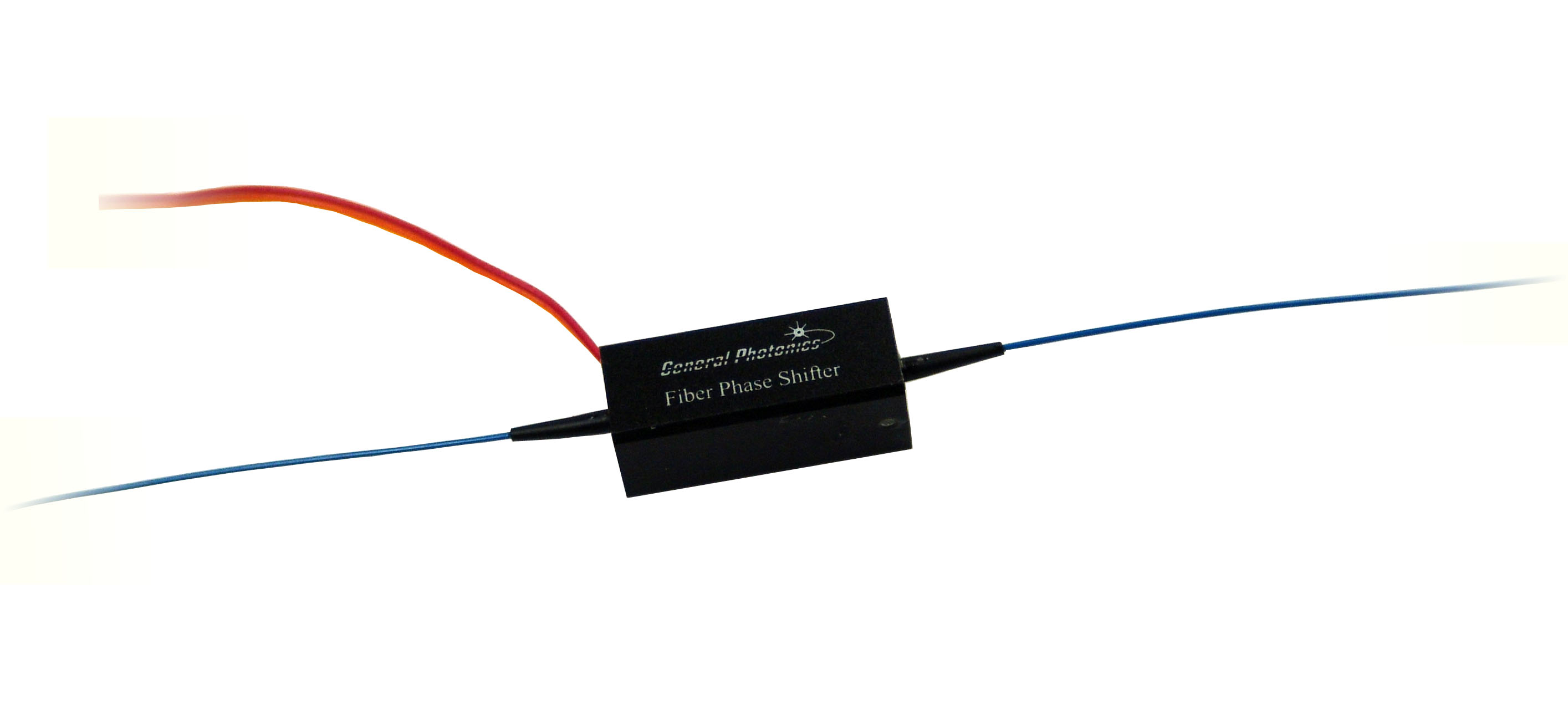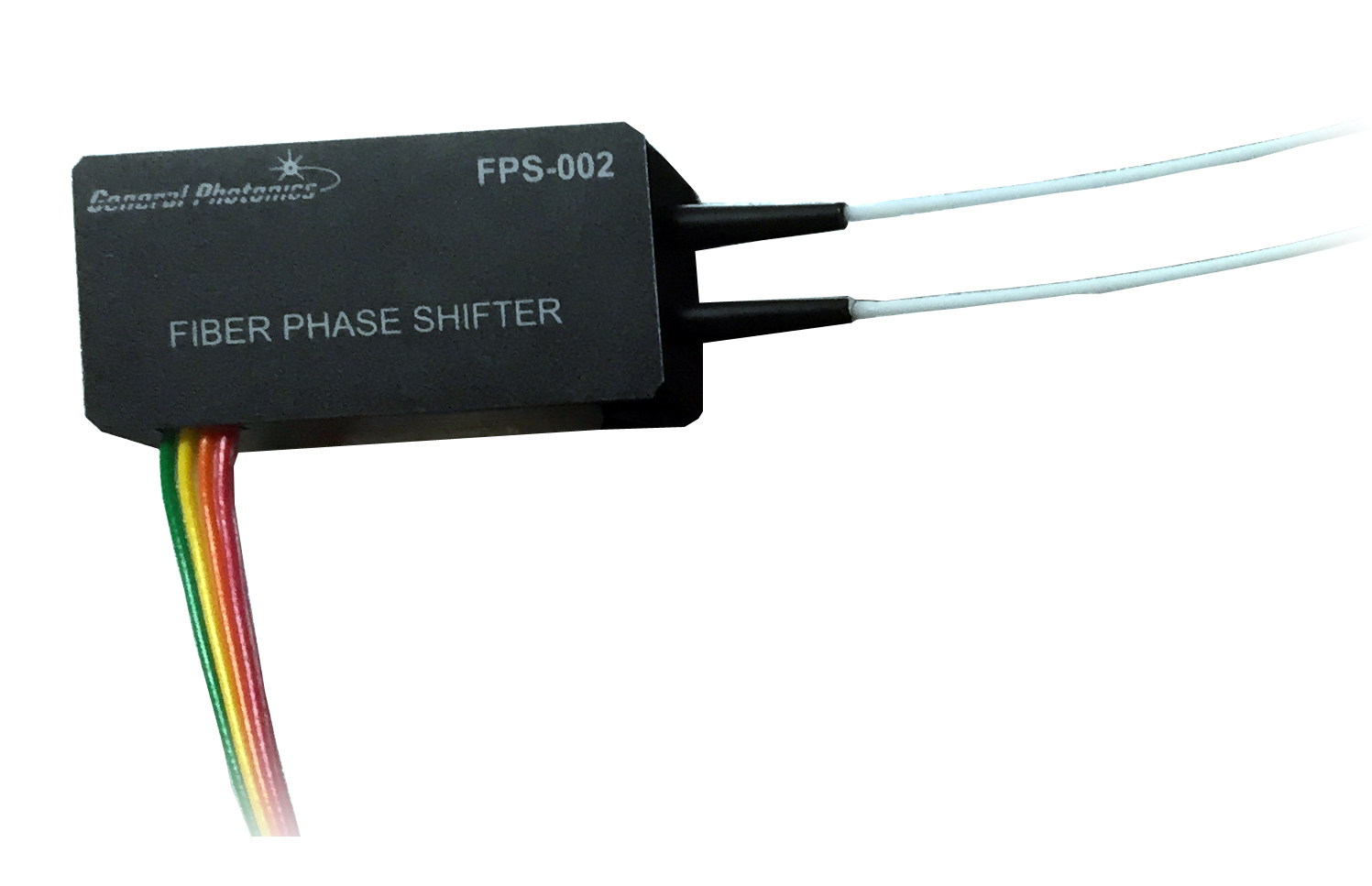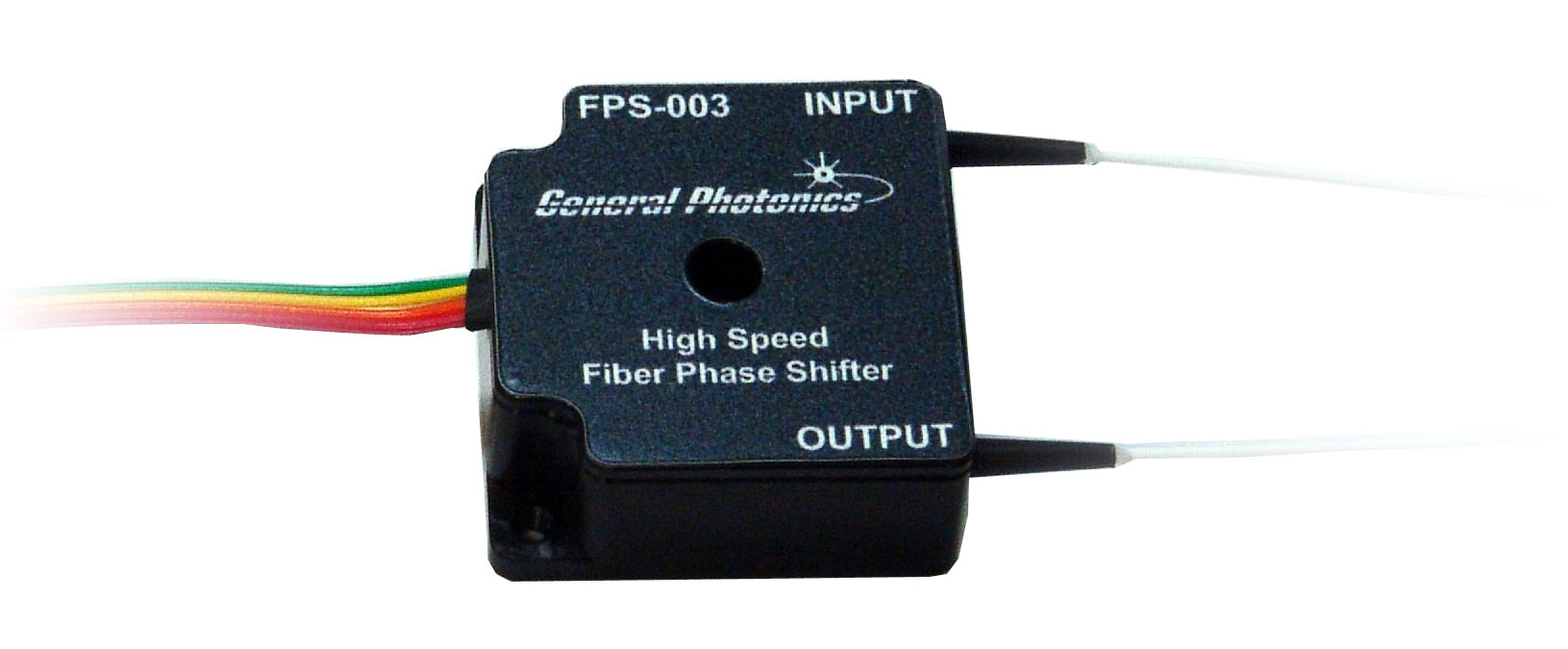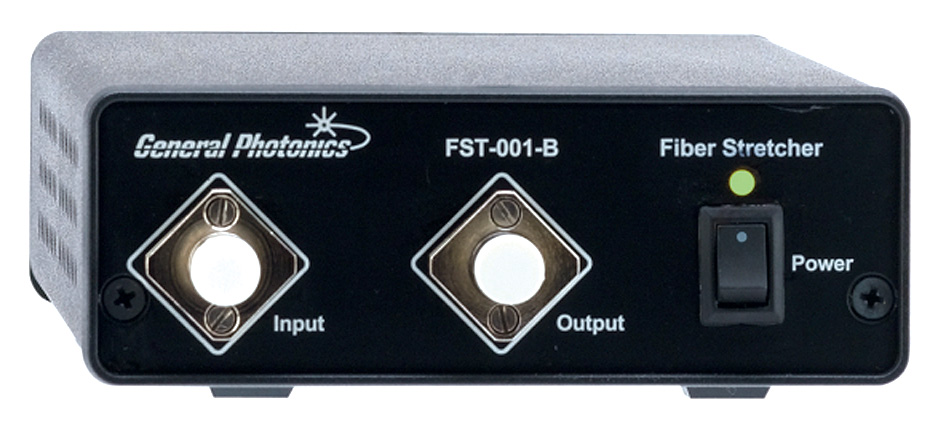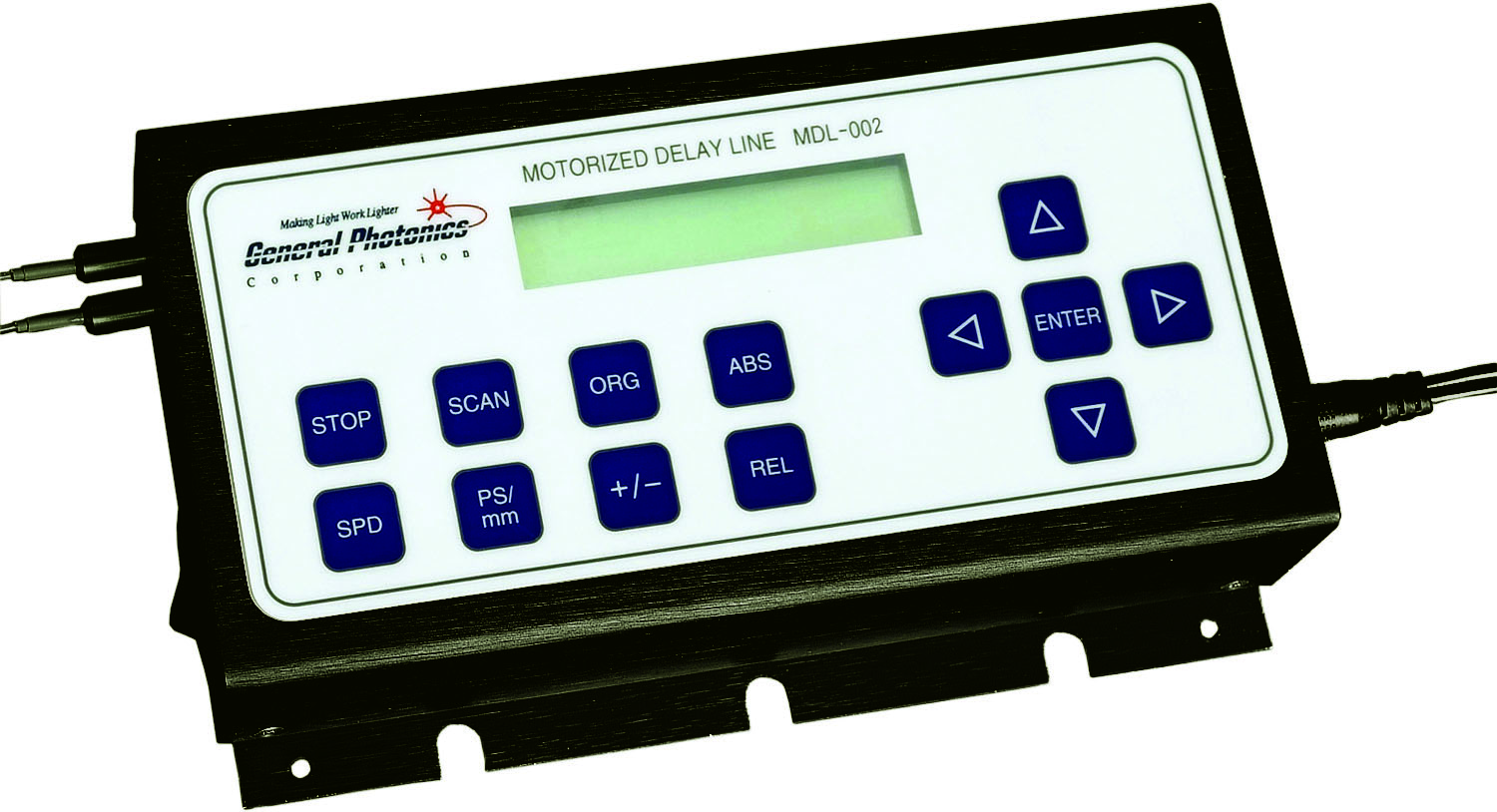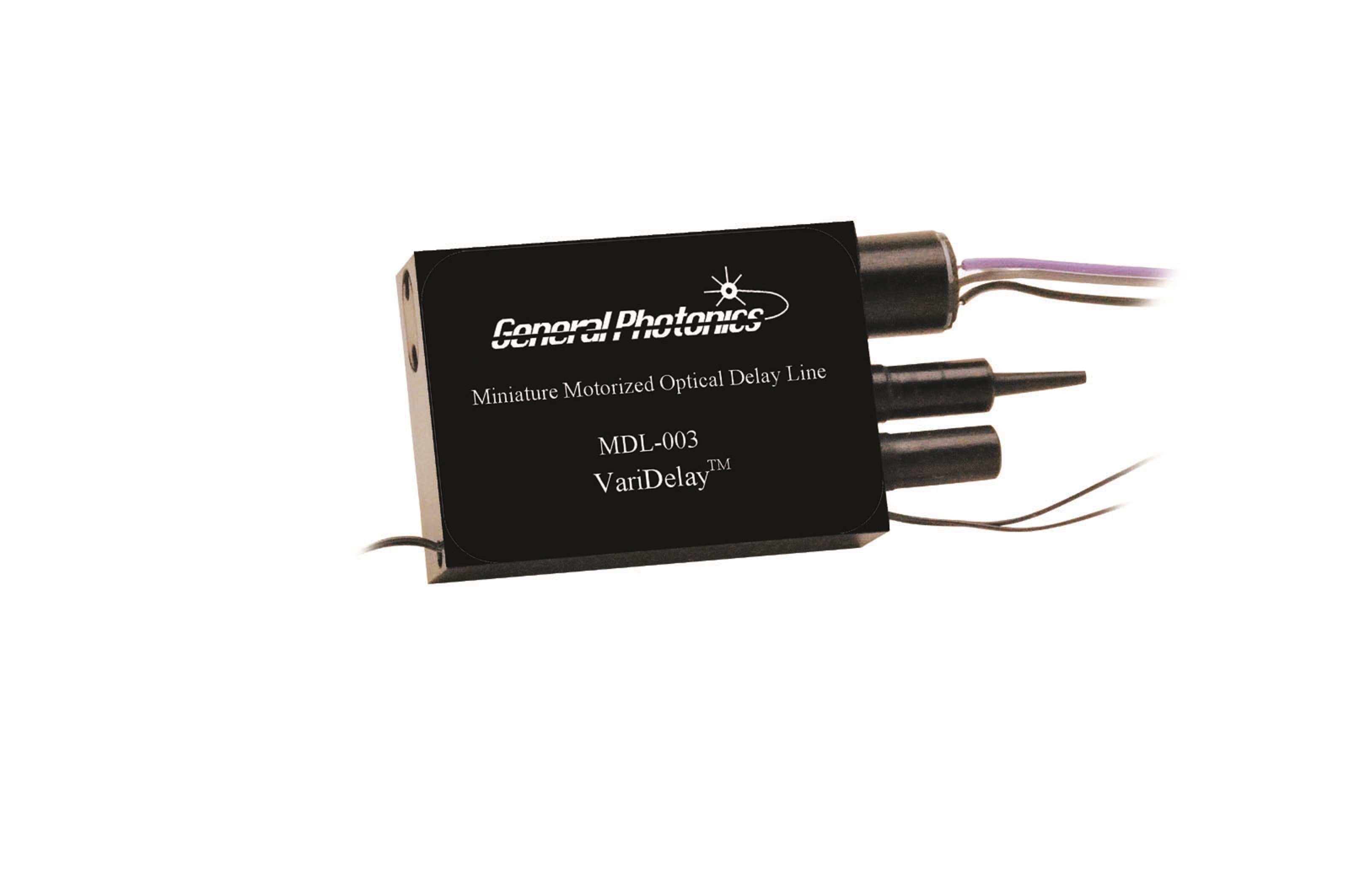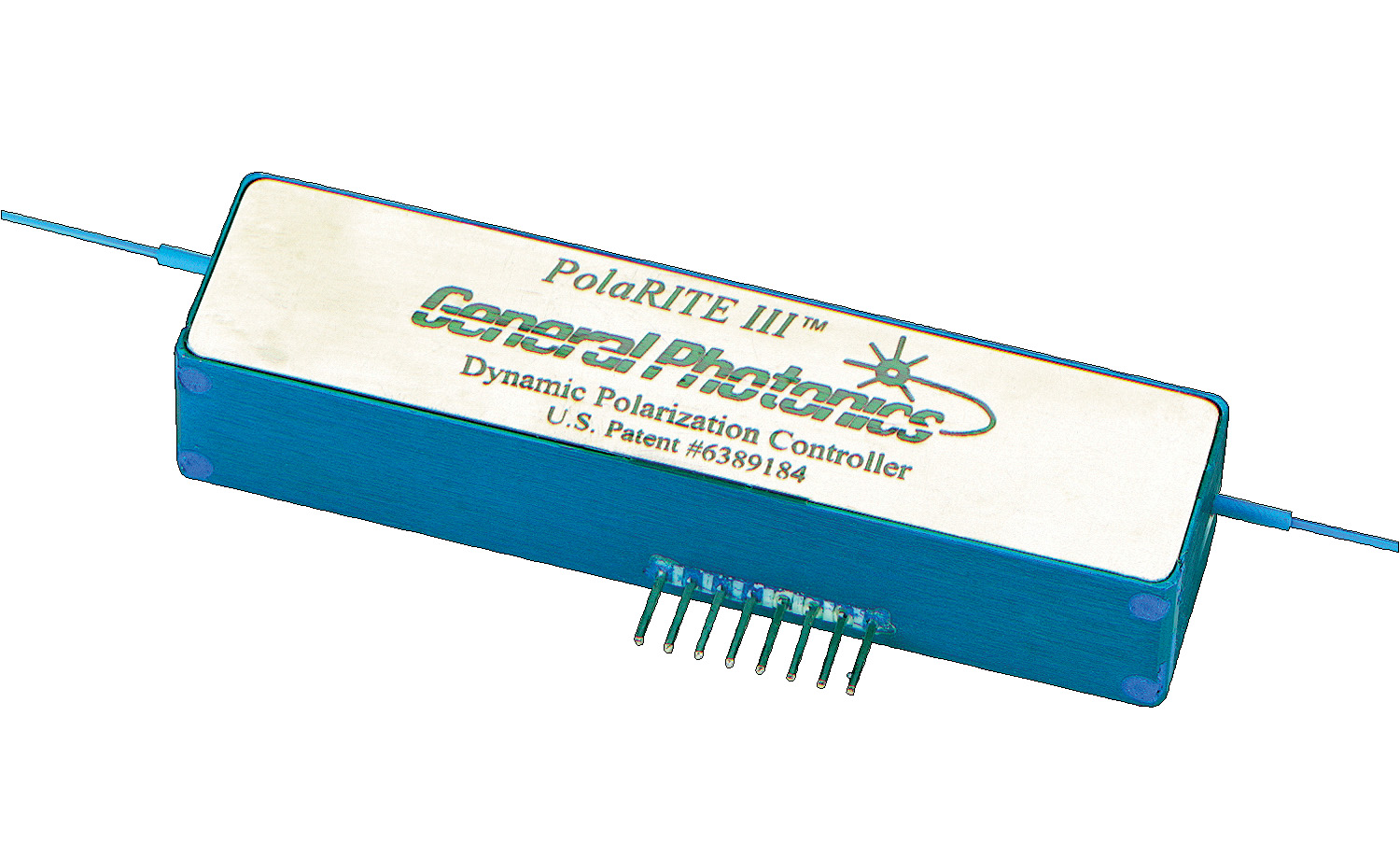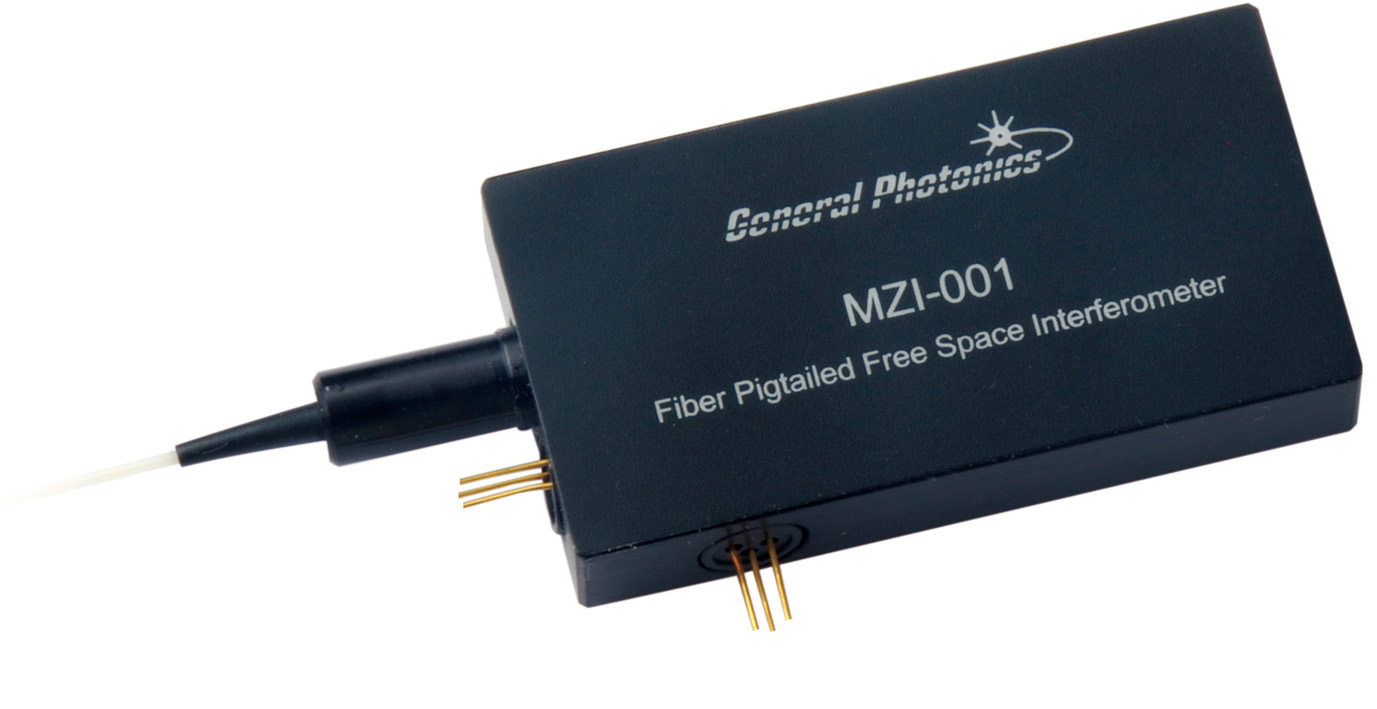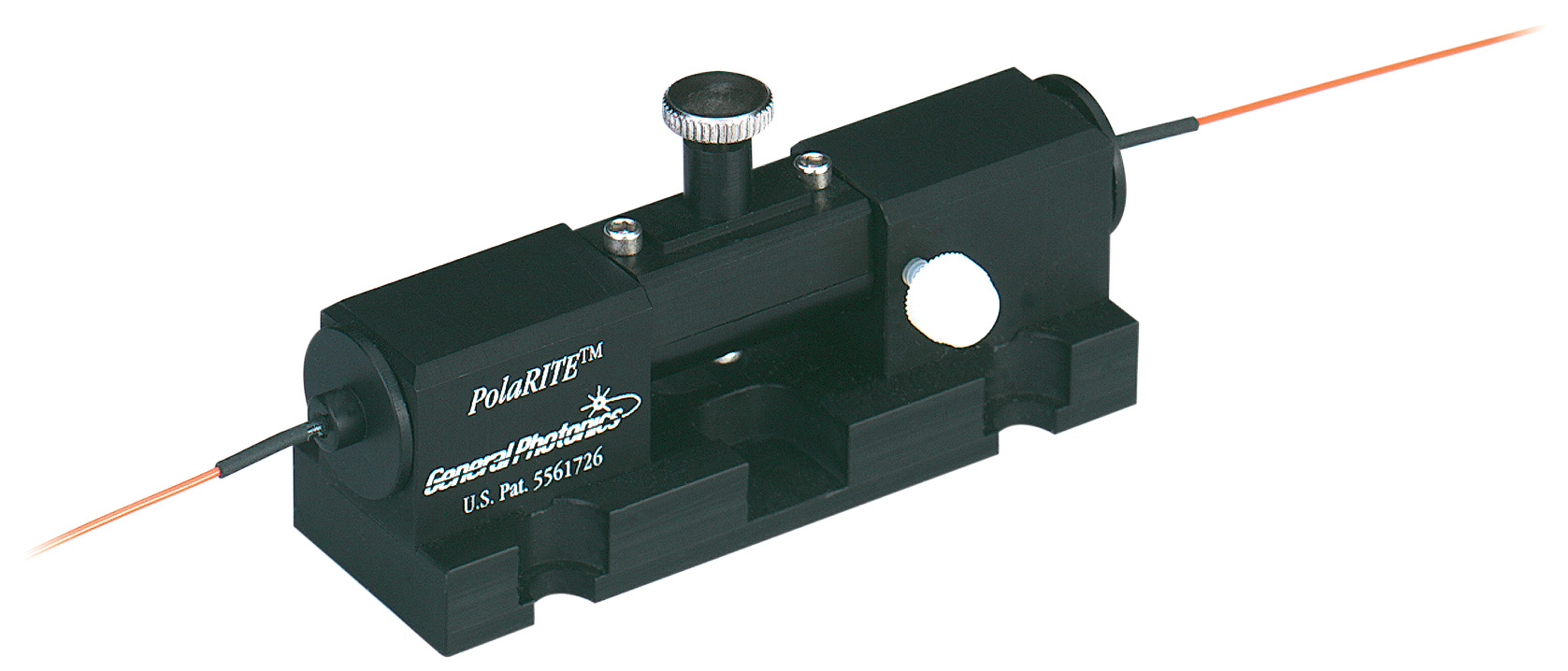Filter
–
General Photonics
DOP-201 Degree of Polarization Meter
1260-1620 nm; DOP Accuracy 0.2%, 0.5%; DOP Range 0-100%; DOP Resolution 0.01%; Operating Power Range -40-6dBm
General Photonics’ DOP-201 system measures and displays the degree of polarization (DOP) of a light source in real time on the front panel display. The instrument incorporates a patented maximum & minimum search technique that accurately measures both low and high DOP with a wide dynamic range. This technique is superior to polarimeter-based methods that are inaccurate at low values of DOP as well as scrambler-based methods which are less accurate at high values of DOP.
The instrument's wide wavelength range includes the S, C and L bands, without calibration. Simultaneous measurement of DOP and optical power level of the light source under test can be used to obtain DOP power dependence and to ensure low insertion loss during depolarizer manufacturing.
The DOP-201 degree of polarization meter is ideal for characterizing the performance of depolarizers and depolarized light sources, such as ASE and SLED sources and the pumps for Raman amplifiers. It can also be used to monitor the OSNR (optical signal-to-noise ratio) and PMD (polarization mode dispersion) of optical signals, and to measure the noise figure of optical amplifiers.
The DOP-201 features fast measurement, high accuracy and resolution, a wide operating power range, a bright OLED display and an analog output port for easy integration in automated depolarizer manufacturing stations.
Key Features:
Rapid Measurement Speed: 30 ms
Degree of Polarization (DOP) Wavelength Independence
High DOP Accuracy: ±0.5% for Single Sample, ±0.2% for 10 Sample Average
Wide Operating Wavelength Range: 1260 to 1620 nm
DOP Range: 0 to 100%
DOP Resolution: 0.01%
Operating Power Range: -40 to 6 dBm
Front Panel Real-time Display
Analog Output
Dimensions: 356 x 216 x 89 mm
Applications: Characterizing Depolarizers and Depolarized Light Sources, Such as ASE and SLED Sources and the Pumps for Raman Amplifiers; Monitoring OSNR and PMD of Optical Signals; Measuring the Noise Figure of Optical Amplifiers; Depolarizer Manufacturing and QC; Fiber Gyro Coil Characterization; ROADM Manufacturing
Product number:
SW11282
Manufacturer:
General Photonics
ERM-202 Extinction Ratio Meter
600-1620 nm; No. of Channels 1, 2; PER Resolution 0.1 dB; PER Dynamic Range >40, >50 dB; Angular Resolution 0.06 dB; Input Optical Power Range -30-10 dBm; Power Resolution 0.02, 0.2 dB; Measurement Speed 0.1-10 s
General Photonics’ ERM-202 is a single or dual channel polarization extinction ratio (PER) meter. When used with a broadband source, it directly measures PER. Single and dual channel models are available. The single channel instrument can be upgraded to a dual-channel version at a later date.
The dual channel version is specifically designed to simultaneously measure the PER and power ratio of a device with two polarization maintaining (PM) outputs, such as a Y-branch fiber gyro IOC, PM coupler (PMC), or polarization beam splitter (PBS), as well as evaluate the performance (output DOP) of depolarizers.
By combining low-noise circuitry with a high-resolution stepper, the ERM series achieves a PER dynamic range of 50 dB and an angular resolution of 0.06°, outperforming all competitors in its class. These instruments feature OLED displays with a high contrast bright readout that allows the data to be observed from several feet away. The instruments can be operated from the front panel or via remote control.
The operator can choose from four measurement speeds ranging from 0.1 to 1 s/cycle to optimize speed or accuracy and can observe multiple parameters on the front panel screen including PER, axis angle, power ratios, and optical power. The measurement data can be stored and recalled for comparison purposes from the front panel as well. Full digital or remote control is included for unattended or system applications.
Key Features:
One or Two Measurement Channels
Free-space Input
Front Panel or Remote Control
Simultaneous Polarization Extinction Ratio (PER) and Power Ratio Testing
PER Resolution: 0.1 dB
PER Dynamic Range: >40, >50 dB
High Angular Resolution: 0.06 dB
Operating Wavelength Range: 1260 to 1620 nm, 960 to 1160 nm, 600 to 850 nm
Input Optical Power Range -30 to 10 dBm
Power Resolution: 0.02, 0.2 dB
Measurement Speed: 0.1 to 10 s
Bright OLED Display
Store and Recall Functions
Dimensions: 356 x 216 x 89 mm
Applications: Verification of PM Connectorization and Splices; Testing PM Fiber Coils; Simultaneous Measurement of PER and Power Ratio; Testing Y-branch Fiber Gyro IOCs; Testing PM Couplers (PMC) or Polarization Beam Splitters (PBS); Evaluating the Performance of Depolarizers; Laser Diode PM Fiber Pigtailing; PM Fiber Patchcord Production; PM Fiber Fusion Splicing QA; PM Fiber Coil and Fiber Gyro QA
Product number:
SW11281
Manufacturer:
General Photonics
FDE-002 Fixed Differential Group Delay
1550 nm; DGD 0-45 ps; RL 55 dB; IL 0.8 dB; Fiber Type SMF-28; PDL <0.2 dB
General Photonics’ FDE-002 fixed differential group delay (DGD) artifacts eliminate the need for precise measurement of polarization maintaining (PM) fiber lengths to add defined amounts of first order PMD to a system.
DGD values of up to 45 ps are available in the FDE-002 fixed differential group delay standard size package. Larger DGD values are also available by special request.
Key Features:
Large 1st Order PMD: up to 45 ps
Low Insertion Loss (IL): <1 dB (0.8 dB Typical)
Operating Wavelength: 1550 ± 50nm
DGD Value: 0 to 45 ps Standard, Larger Values on Request
DGD Calibration Accuracy: ±(1 fs + DGD x 0.5%)
Insertion Loss (intrinsic): < 1 dB (0.8 dB typical)
Polarization Dependent Loss (PDL): <0.2 dB
Return Loss (RL): 55 dB
Power Handling: >300 mW
Fiber Type: SMF-28
Dimensions: 108 × 7.9 x 7.9 mm
Applications: PMD Emulation; PMD Compensation; TDM Bit Alignment
Product number:
SW11309
Manufacturer:
General Photonics
FPS-001 Phase Shifter
980-1650 nm; Total Phase Shift >8π; IL <0.1 dB; RL >65 dB; PDL <0.05 dB; Residual Amplitude Modulation ±0.01 dB
General Photonics’ FPS-001 is an all-fiber device that shifts or modulates phase by up to 15π at frequencies from DC to 20 kHz. The advantage of the all-fiber construction is that insertion loss and back reflection are reduced to near zero.
Key Features:
Low Insertion Loss (IL): < 0.1 dB
Low Residual Amplitude Modulation: ±0.01 dB
NoTail™ Version Available
Operating Wavelength: 1260 to 1650, 980 to 1310 nm
Return Loss (RL): >65 dB
Total Phase Shift (0 to 20 kHz): >8π
Half-wave Voltage (0 to 20 kHz): <20 V
Polarization Dependent Loss (PDL): <0.05 dB
Maximum Applied Voltage: 150 V
Dimensions: 35 x 14 x 14 mm (Pigtail), 74 x 14 x 14 mm (NoTail™)
Applications: Precision Phase Tuning or Phase Modulation in Fiber Interferometers, Sensor Systems, Fiber Laser Systems or Fiber Resonators
Product number:
SW11304
Manufacturer:
General Photonics
FPS-002 Phase Shifter
780-1550 nm; Total Phase Shift >65π; IL <0.5 dB; RL >50, >55, >58 dB; PDL <0.05, <0.1 dB; Residual Amplitude Modulation ±0.01 dB
Coherent or interferometric sensor systems, such as distributed acoustic sensors (DAS), often require a low-loss, low-cost phase shifter or modulator to obtain the desired sensing signals. General Photonics’ FPS-002 is an all-fiber device that shifts or modulates phase shifts up to 75π at frequencies from DC to 20 kHz.
The FPS-002 phase shifter requires a lower half-wave voltage than the FPS-001 phase shifter module: only 2 V compared to up to 20 V. Like the FPS-001, it is an all-fiber design and offers the benefits of low loss and back reflection. Two different size packages (small frame or large frame) are available to accommodate the bend diameter requirements of different fibers.
Key Features:
Low Insertion Loss (IL): <0.5 dB (at λc, Excluding Connectors)
Low Polarization Dependent Loss (PDL): <0.05 dB (SM), <0.1 dB (PM)
Return Loss (RL): >58 dB (Without Connectors), >55 dB (With APC Connectors), >50 dB (With PC Connectors)
Low Residual Amplitude Modulation: ±0.01 dB at 1550 nm
Total Phase Shift (@500 Hz, Vpp = 150 V): >65π (@ 1550 nm)
Low Half-wave Voltage (@ 500 Hz): 2.5 to 4.5 V Typical (Small Frame), 0.7 to 1.5 V Typical (Large Frame)
Operating Wavelength: 780, 1060, 1310, 1550 nm
Fiber Type: ClearCurve ZBL, HI1060, 780 HP, PM, PM980XP
Capacitance of Piezo: 0.18 µF
Maximum Applied Voltage: 150 V
Compact Size: 35 x 17 x 10 mm (Small Frame), 45 x 27 x 11 mm (Large Frame)
Applications: Fiber Interferometers; Fiber Laser Systems; Fiber Sensor Systems
Product number:
SW11310
Manufacturer:
General Photonics
FPS-003 Phase Shifter
780-1550 nm; Total Phase Shift >55π; IL <0.5 dB; RL >55 dB; PDL <0.05 dB; Residual Amplitude Modulation ±0.01 dB
General Photonics’ FPS-003 all-fiber phase shifter/modulator combines a wide modulation bandwidth (up to 60 kHz) with low half-wave voltages to create a long-range device that can be driven by standard function generators.
Like General Photonics’ other phase shifters, it employs all fiber construction and has low insertion loss and back reflection. In addition to fiber sensor systems, this compact device is ideal for fiber laser systems, fiber resonators, and fiber interferometers for precision phase tuning or phase modulation.
Key Features:
Wide Frequency Range - Operating Wavelength: 780, 1060, 1310 or 1550 nm
Low Half-wave Voltage
Large Phase Shift Range
Compact Size: 31 x 31 x 14.5 mm
Low Insertion Loss (IL): <0.5 dB (at 1550 nm, Excluding Connectors)
Return Loss (RL): >55 dB (Excluding Connectors)
Low Residual Amplitude Modulation: ±0.01 dB (@ 1550 nm)
Total Phase Shift (@500 Hz, Vpp = 150 V): >55π (@ 1550 nm)
Fiber Type: ClearCurve ZBL, 780 HP, PM, Other
Half-wave Voltage (Vπ @ 500 Hz): 1 to 3 V Typical
Resonance Frequency: 36 to -39 kHz Typical
Vπ at Resonance Frequency: <150 mV Typical
Polarization Dependent Loss (PDL): <0.05 dB at 1550 nm
Capacitance of Piezo: 5 to 12 nF
Maximum Applied Voltage: 150 V
Applications: Fiber Interferometers; Fiber Laser Systems; Fiber Sensor Systems
Product number:
SW11311
Manufacturer:
General Photonics
FST-001 Fiber Stretcher
1260-1650 nm; Delay Range >3 mm; RL >65 dB; Fiber Type SMF-28, Other; IL <0.2 dB; PDL <0.05 dBGeneral Photonics’ FST-001 is a piezo-driven fiber stretcher with an optical delay range of up to 3 mm. The device, including the piezo driver, is packaged in a metal enclosure.Each of the FST-001 fiber stretcher’s four piezos can be controlled independently, allowing high resolution or large stroke. Piezos can be controlled with an analog signal or a 12-bit TTL signal.Under analog control, the driving circuit acts as a 4-channel voltage amplifier with 30V/V amplification. Alternatively, the output voltage can be controlled by a computer equipped with a digital I/O card, or by a microprocessor.Key Features: Large Optical Path Delay Range: >3 mm (In Air)High SpeedLow Insertion Loss (IL): <0.2 dBAnalog and Digital ControlAnalog Input: 4 Channels, 4.7 V Maximum For Each ChannelDigital Input: 20-pin Connector, 12-bit TTL Control SignalOperating Wavelength: 1260 to 1620 nmMaximum Optical Power: 1,000 mWPhase Change Sensitivity: 810 π/VInternal Voltage Amplification: 30 V/VMaximum Voltage on Piezo: 140 VResonance Frequency: 2.2 ±0.3 kHzReturn Loss (RL): >65 dBPolarization Dependent Loss (PDL): <0.05 dBFiber Type: SMF-28, Other on Request Dimensions: 170 x 106 x 39 mmApplications: Sensors; Interferometers; Medical Imaging; Spectrum Analysis; OCT.
Product number:
SW11303
Manufacturer:
General Photonics
MDL-002 Fiber Optic Delay Lines
840-1650 nm; Delay Range 0-1,120 ps; RL 50 dB; Fiber Type SMF-28, HI1060, HI780, PM Panda, PM 980 Panda; IL 1.0, 1.5 dB; PDL 0.1, 0.2 dB
General Photonics’ MDL-002 family of motorized variable fiber optic optical delay lines allow optical path length adjustment of up to 560 ps in a single pass. Driven by a DC motor with an integrated encoder, the MDL-002 has a delay resolution of less than 0.3µm (1 fs).
In addition, its advanced motion design guarantees longevity for long-term continuous operation. Low insertion loss and high reliability make this device ideal for integration in optical coherence tomography (OCT) systems, network equipment and test instruments for precision optical path length control or timing alignment.
Three configurations of the MDL-002 fiber optic delay line series are available:
Integrated unit for use as a bench-top instrument for laboratory applications
Two-piece unit with the optical head and control unit separated for installation into customer equipment
OEM version with a miniature controller board
All three versions can be remote controlled by a PC or a micro-processor through an RS-232 interface. The delay line is available with either single mode (SM) or polarization maintaining (PM) fiber pigtails.
Key Features:
High Optical Delay Resolution: 0.3 µm / 1 fs, 0.6 µm / 2 fs Per Encoder Count
Low Backlash
Low Insertion Loss (IL): 1.0, 1.5 dB Typical
Insertion Loss Variation: ±0.3, ±0.5, ±0.7 dB Over Entire
High Delay-to-Length Ratio
Optical Delay Range: 0 to 330, 0 to 560, 0 to 1,120 ps
Operating Wavelength: 840 to 1650 nm
Position Accuracy: ±3, ±6 µm
Position Repeatability: ±3, ±6 µm
Polarization Dependent Loss (PDL): 0.1, 0.2 dB Maximum
Return Loss (RL): 50 dB
Extinction Ratio: >18 dB (For PM Model)
Optical Power Damage Threshold: 300 mW
Control Mode: Panel Keypad and RS-232 Interface
Fiber Type: SMF-28, HI1060, HI780, PM Panda, PM 980 Panda
Dimensions: 178 x 102 x 41, 229 x 112 x 41 mm (Integrated Unit), 65 x 65 x 21.5 mm (Mini Controller Board), 132/157 x 37 x 18 mm (Optical Head)
Applications: Optical Coherence Tomography (OCT) Systems; Scientific Instrument Control; Network Optical Path Length Control or Timing Alignment; Optical Fourier Spectrum Analysis; Optical Interferometry; Delay Generation and Measurement; Optical Time Division Multiplexing (OTDM); Fiber Sensors
Product number:
SW11302
Manufacturer:
General Photonics
MDL-003 Fiber Optic Delay Line
840-1650 nm; Delay Range 0-100, 0-200 ps; RL 55 dB; Fiber Type SMF-28, HI780, HI1060, PM Panda; IL 1 dB; PDL 0.15 dB
General Photonics’ motorized variable optical delay line is the smallest delay line in the MDL series of products, with a total volume of less than 2 cubic inches. The MDL-003 provides low-cost, precision optical path length adjustment and delay scanning functionality. This addition to the MDL product line is specifically designed for OEM applications that require continuous scanning capability and a small footprint.
The standard MDL-003 motorized variable optical delay line has a delay range of 100 ps; however an internal mirror can be installed to double pass the light, thereby doubling the delay range. The device uses a stepper motor and dual position sensors for precise control. A small controller board is available as an option.
Key Features:
High Resolution
Low Backlash
Low Insertion Loss (IL): 1 dB
Insertion Loss Variation: ±0.3 dB Over Entire Range
High Delay-to-Length Ratio
Operating Wavelengths: 840, 1060, 1310, 1550 or 1260 to 1650 nm
Optical Delay Range: 0 to 100 ps, Single-pass
Optical Delay Resolution: 30 μm, Single-pass at Maximum Speed
Optical Delay Accuracy: ±40 μm, Single-pass at Maximum Speed
Optical Delay Repeatability: ±40 μm, Single-pass at Maximum Speed
Polarization Dependent Loss (PDL): 0.15 dB (SM Fiber)
Return Loss (RL): 55 dB
Extinction Ratio: >18 dB (PM Model)
Actuation Speed: 50 ps/s (Single-pass) Maximum
Optical Damage Power Threshold: 100 mW
Fiber Type: SMF-28, HI780, HI1060, PM Panda
Dimensions: 51 x 36 x 14 mm
Applications: Optical Coherence Tomography (OCT) Systems; Scientific Instrument Control; Network Optical Path Length Control or Timing Alignment
Product number:
SW11308
Manufacturer:
General Photonics
MPC Polarization Controller
1260-1650 nm; IL 0.05 dB; PMD 0.05 ps; AL <0.01, <0.05 dB; RL >65 dB; Max. Rise & Fall Time 30 µs
General Photonics’ MPC all fiber polarization controller module is packaged in a low-profile, 16 mm high enclosure, suitable for system integration and mounting on a PCB. The module’s low height is especially advantageous for integration in test equipment, fiber sensors, fiber lasers and optical network modules.
Available with three (-3x) and four channels (-4x), the MPC polarization controller module features an all-fiber design with inherently low loss, minimal activation loss and minimal back reflection. A special athermal design leads to stable operation over a wide range of temperatures (-25 to +80 °C).
Combined with General Photonics’ miniature piezo driver card, it can be controlled either by a digital or analog signal to obtain any desired polarization output from an arbitrary input polarization state.
Key Features:
OEM Packaging
All-fiber Design
Low Intrinsic Insertion Loss: 0.05 dB
Low Back Reflection – Return Loss: >65 dB
Fast Response – Maximum Rise and Fall Time: 30 µs
Operating Wavelength Range: 1260 to 1650 nm
Maximum Activation Loss (AL): 0.01, 0.05 dB
Polarization Mode Dispersion (PMD): 0.05 ps
Compact Size – Dimensions: 65.5/83 x 20.3 x 16 mm
Applications: Polarization Stabilization; Compensate PMD in Fiber Sensing Systems; Polarization Demultiplexing; Fiber Sensor; Fiber Laser; Testing Equipment
Product number:
SW11288
Manufacturer:
General Photonics
MPC-201 Polarization Controller
980-1620 nm; Multiple Polarization Control Modes; IL <0.6 dB; PDL <0.1 dB; PMD <0.2 ps; AL <0.1 dB; RL >50 dB
Controlling the state of polarization (SOP) of an optical signal has never been easier – General Photonics’ MPC-201 multifunction polarization controller has four operational modes for complete polarization control: variable rate polarization scrambling, manual polarization adjustment, polarization modulation, and externally triggered random SOP generation.
Four different polarization scrambling methods enable the SOP to a) trace out a spiral pattern about a static or rotating axis with a nearly uniform SOP variation rate for system stress tests (Tornado scrambling); b) generate a continuous trace with a Rayleigh distribution of SOP variation rate, for emulation of the SOP variation in a fiber link (Rayleigh scrambling); c) generate a continuous trace with uniform sphere coverage for PDL measurement (Triangle scrambling); or d) evenly cover the Poincaré sphere with discrete, random points at a uniform rate (Discrete scrambling).
In the SOP modulation mode, each polarization control axis can be selectively controlled with a sine, square, or triangle wave of user defined frequency and amplitude. Each polarization control axis can also be controlled manually, by setting the input voltage either from the front panel controls or through a remote control interface. In externally triggered scrambling mode, discrete, random SOPs are generated in response to a trigger input, a feature desirable for recirculating loop applications or other applications requiring synchronization with other devices.
Finally, the MPC-201 can emulate the Agilent 11896A polarization scrambler function, allowing it to act as a plug-in replacement for this popular but discontinued device, while offering many more advanced features. The MPC-201 polarization controller puts the user in control.
Key Features:
Multiple Polarization Control Modes
Tornado Scrambling (Quasi-uniform Rate Distribution): 0.00 to 2,000 Revolutions/s
Real Fiber SOP (State of Polarization) Variation Emulation (Rayleigh Rate Distribution): 0.00 to 2,000 rad/s
Discrete Random States SOP Scrambling: 0.00 to 20,000 Points/s
Triangle Polarization Scrambling: 0.00 to 2,000 x 2π rad/s
Agilent 11896A Scrambling Emulation: Speed Settings 1 to 8, Matched to 11896A Settings
SOP Modulation
Operating Wavelength Range: 1260 to 1620 nm, 980 to 1310 nm
Manual Polarization Control: 4 Channels, 0 to 4π Each Channel
Low Insertion Loss (IL): <0.5 dB With Connectors
Low Polarization Dependent Loss (PDL): <0.05 dB With Connectors
Low Polarization Mode Dispersion (PMD): <0.1 ps With Connectors
Low Activation Loss (AL): <0.05 dB With Connectors
Return Loss: >50 dB With Connectors
Optical Power Handling: 1,000 mW
Bright OLED Display
Applications: Recirculating Loop Studies; Automated Testing; Real Fiber Emulation; SOP Variation Emulation; PMD Emulation; Polarization Scrambling; System Polarization Studies; PDL/DOP Measurement
Product number:
SW11271
Manufacturer:
General Photonics
MPC-202 Polarization Controller
980-1620 nm; SOP Change Rate >360 krad/s; IL <0.6 dB; PDL <0.1 dB; PMD <0.2 ps; AL <0.1 dB; RL >50 dB
General Photonics’ MPC-202 advanced multifunction polarization controller is specially designed to meet the requirements of coherent receiver performance tests.
MPC-202 combines General Photonics’ award winning PolaRite™ II/III polarization controller with proprietary polarization control algorithms to achieve a wide range of polarization control functionalities, including high-speed quasi-uniform rate polarization scrambling, random-rate polarization scrambling with Rayleigh rate distribution, discrete-state polarization scrambling with high slew rate, sine, square, and triangle-wave SOP (state of polarization) modulation, and manual polarization control functions.
In particular, the “Tornado” quasi-uniform rate polarization scrambling function can achieve a high SOP scrambling rate of up to 60,000 revolutions/s (more than 360 krad/s) with a narrow rate distribution clustered around the highest rate.
In short, the MPC-202 is an ideal tool for production or laboratory testing of polarization related functions and parameters, including passive/active component characterization, performance tests of fiber optic interferometers, sensor systems, RF photonics systems, etc. The quasi-uniform rate high-speed scrambling function is particularly useful for SOP tracking speed testing of coherent receivers, and the square wave SOP modulation function is ideal for SOP recovery time tests.
Key Features:
Quasi-uniform Rate SOP (State of Polarization) Scrambling
SOP Change Rate: >360 krad/s
Scrambling With Rayleigh Rate Distribution
Discrete SOP Scrambling
SOP Modulation
Operating Wavelength Range: 1260 to 1620 nm, 980 to 1310 nm
Tornado Polarization Scrambling: 0.00 to 60,000 Revolutions/s
Mean Rayleigh Rate Distribution Polarization Scrambling: 0.00 to 2,000 rad/s
Triangle Polarization Scrambling: 0.00 to 2,000 x 2π rad/s
Discrete Random States Polarization Scrambling: 0.00 to 20,000 points/s
Manual Polarization Control: 4 Channels, 0 to 4π Each Channel
Low Insertion Loss (IL): <0.6 dB With Connectors
Low Polarization Dependent Loss (PDL): <0.1 dB With Connectors
Low Polarization Mode Dispersion (PMD): <0.2 ps With Connectors
Low Activation Loss (AL): <0.1 dB With Connectors
Return Loss: >50 dB With Connectors
Optical Power Handling: 1,000 mW
Bright OLED Display
Applications: Laboratory Testing of Polarization-related Parameters; Performance Tests of Fiber Optic Interferometers and Systems; SOP Tracking Speed Testing of Coherent Receivers
Product number:
SW11270
Manufacturer:
General Photonics
MPC-203 Polarization Controller
980-1620 nm; SOP Change Rate ≤11 Mrad/s; IL <0.6 dB; PDL <0.1 dB; PMD <0.2 ps; AL <0.1 dB; RL >50 dB
General Photonics’ MPC-203 high-speed multifunction polarization controller is specially designed to meet the high SOP (state of polarization) scrambling requirements needed for stress testing a coherent receiver’s polarization tracking performance.
MPC-203 combines General Photonics’ award winning PolaRite™ II/III polarization controller with proprietary polarization control algorithms to achieve a wide range of polarization control functionalities, including high-speed polarization scrambling with a maximum SOP change rate of up to 11 Mrad/s.
Unlike other high-speed polarization scramblers found in the market, this all-fiber, pass-through design ensures low insertion loss (IL), polarization dependent loss (PDL), polarization mode dispersion (PMD) and activation loss (AL).
Key Features:
High-speed SOP (state of polarization) Scrambling
SOP Change Rate up to 11 Mrad/s
Scrambling With Rayleigh Rate Distribution
Discrete SOP Scrambling
SOP Modulation
Operating Wavelength Range: 1260 to 1620 nm, 980 to 1310 nm
Tornado Polarization Scrambling: 0 to 11 Mrad/s
Mean Rayleigh Rate Distribution Polarization Scrambling: 0.00 to 2,000 rad/s
Triangle Polarization Scrambling: 0.00 to 2,000 x 2π rad/s
Discrete Random States Polarization Scrambling: 0.00 to 20,000 points/s
Manual Polarization Control: 4 Channels, 0 to 4π Each Channel
Low Insertion Loss (IL): <0.6 dB With Connectors
Low Polarization Dependent Loss (PDL): <0.1 dB With Connectors
Low Polarization Mode Dispersion (PMD): <0.2 ps With Connectors
Low Activation Loss (AL): <0.1 dB With Connectors
Return Loss: >50 dB With Connectors
Optical Power Handling: 1,000 mW
Bright OLED Display
Applications: SOP Response Test of Coherent Receivers; SOP Tracking Speed Test; PMD and PDL Related Tests; SOP Variation Emulation; Polarization Scrambling
Product number:
SW11269
Manufacturer:
General Photonics
MZI-001 Mach-Zehnder Interferometer
1060, 1310, 1550 nm; Wavelength Range ±70 nm; FSR 10-100 GHz; Detector Responsivity >0.8 A/W; Connector Type FC/APC, FC/PC, Specify
General Photonics’ MZI-001 is a fiber pigtailed Mach-Zehnder free space interferometer that detects changes in optical frequency. The device comes with two high-speed photodetectors for the balanced detection of the two complementary outputs of the interferometer.
The free spectral range (FSR) or zero-cross spacing of the device is defined to within 1. The FSR is user-defined between 10 GHz and 100 GHz. The MZI-001 interferometer’s free-space optical design eliminates polarization sensitivity.
Key Features:
Accurate Free Spectral Range (FSR): 10 to 100 GHz, User Selectable
FSR Tolerance: 2%
Center Wavelength: 1060, 1310, 1550 nm
Wavelength Range: ±70 nm
Detector Responsivity: >0.8 A/W
Detector Rise/Fall Time: 0.3 ns With 50 Ω Load
Detector Capacitance: 0.7 pF
Temperature Stable
Polarization Insensitive
Fine Optical Frequency Spacing
Balanced Photodetectors
Return Loss (RL): 55 dB
Polarization Dependent Loss (DPL): <0.5 dB
Input Fiber: SMF-28 or HI1060 Fiber With 900 µm Buffer
Optical Connectors: FC/APC, FC/PC, Specify
Compact Size: 53.6 x 28 x 9.4 mm
Applications: Determining Instantaneous Wavelength of Swept Source; Clocking Optical Coherence Tomography (OCT) Platforms; Detecting Drift in Fiber Sensor Systems; Detecting Drift of Lasers in Coherent Detection Systems; Spectrum Analysis
Product number:
SW11298
Manufacturer:
General Photonics
OCA-1000 Optical Component Analyzer
1260-1620 nm; 8-40 Channels; PDL Measurement Range 0-20 dB; PDL Resolution 0.01 dB; IL Measurement Range 0-60 dB; IL Resolution 0.002 dB; Optical Power Range -60-8 dBm; Optical Power Accuracy ±0.5 dB
General Photonics’ OCA-1000 is a multi-channel optical component analyzer that simultaneously measures insertion loss (IL), polarization dependent loss (PDL), and optical power (P) on multiple optical paths. The measurement is based on the Mueller Matrix method, which offers fast characterization of wavelength dependent optical parameters that are critical in today’s optical communication systems.
The OCA-1000 base model can have up to eight channels. Custom 8- or 16-channel expansion units can be added to increase the system capacity to up to 40 channels. The instrument comes with a control program with built-in functions to display measured power, IL, and PDL vs. wavelength or to monitor the time variation of power/IL for all channels simultaneously to determine their stability. For AWG characterization, the data analysis software also calculates passband center wavelength, bandwidth, and flatness as well as inter-channel crosstalk (from adjacent and nonadjacent channels).
The OCA-1000 optical component analyzer is an ideal solution for easy, accurate characterization of components and modules with multiple outputs, including DWDMs, ROADMs, AWGs and PLCs. It can be used with various tunable lasers , such as those from Keysight or Santec. This flexibility makes full use of existing laser resources and reduces the cost of making such measurements. Its rapid measurement reduces the time required to characterize devices with large numbers of ports, enabling higher production throughput.
Key Features:
Wide Wavelength Range: 1260 to 1360 nm (O-Band), 1480 to 1620 nm (C- & L-Bands)
Number of Channels: 8 to 40
PDL Measurement Range: 0 to 20 dB
High Polarization Dependent Loss (PDL) Accuracy: ±(0.02 + 2% of PDL) dB @PDL<10dB, ±(0.02 + 5% of PDL) dB @10<PDL<20dB
PDL Resolution: 0.01 dB
Insertion Loss (IL) Measurement Range: 0 to 55 dB, 0 to 60 dB
IL Resolution: 0.002 dB
Optical Power Range: -60 to 8 dBm
Optical Power Accuracy: ±0.5 dB
High Channel-to-channel Uniformity
User-friendly Control Software
Integration Time of Power Meter: 0.5 to 1,000 ms
Dimensions: 19”-Rack-Mountable Enclosure, 1 U, 305 mm Depth
Applications: PDL or IL vs. Wavelength Measurement; IL or Power vs. Time Measurement; DWDM Component Passband Characterization: Center Frequency, BW, Ripple, Noise Floor; Fiber Optic Component Characterization; Network Component Characterization (e.g. DWDM, ROADM); Planar Lightwave Circuits (PLC); Photonic Integrated Circuits (PIC)
Product number:
SW11283
Manufacturer:
General Photonics
OCDR-1000 Optical Coherence Domain Reflectometer
1310, 1550 nm; Dynamic Range >80 dB; Scan Range 600 mm; Spatial Resolution 10-25 µm; RL Range 10-90 dB; Sweep Speed 20 mm/s
General Photonics’ OCDR-1000 is an optical coherence domain reflectometer designed to obtain space-resolved reflection information inside a fiber optical component, such as a photonic integrated circuit (PIC), for diagnosing quality or design issues. It is based on a polarization optimized white light interferometer proprietary to General Photonics.
The OCDR-1000 optical coherence domain reflectometer performs the functions of the discontinued Agilent 8504B Reflectometer – and more – but with better polarization management, spatial resolution and accuracy; larger scan range and dynamic range; and smaller size and weight.
The OCR-1000 is a low-cost alternative to OFDR technology, with a much higher dynamic range that avoids the masking of small reflection peaks by the large reflections typical of the input surface of an optical device.
The OCDR-1000 optical coherence domain reflectometer can measure devices with a length of up to 600 mm. A set of length-matching delay modules is available to match the pigtail lengths of the devices to be measured and place the measurement span in the region of interest. With a reflection dynamic range of over 80 dB and a spatial resolution down to 10 µm, this instrument helps engineers and researchers see the inside of an optical device to precisely identify defects and their locations.
Key Features:
Dynamic Range: >80 dB
Scan Range: 600 mm (400 mm in Fiber)
Spatial Resolution: 10 to 25 μm
Operating Wavelengths: 1310, 1550 nm, Others on Request
Return Loss (RL) Range: 10 to 90 dB
Sweep Speed: 20 mm/s
Compact & Lightweight
Built-in Light Source
Average Light Source Power: >-3 dBm
Performs Functions of Discontinued Agilent 8504B Reflectometer - and More
Dimensions: 89 x 356 x 356 mm
Applications: Optical Characterization of Photonic Integrated Circuits, Fiber Optic Components; Accurate Measurement of Return Loss, Distributed Reflectivity
Product number:
SW11267
Manufacturer:
General Photonics
PBPD-001 Polarization Diverse Balanced Photodetector
Polarization Diverse Photodetector; 1310, 1550 nm; Aluminium Enclosure; Signal Conversion Gain >30 V/mW; RF Bandwidth 0-210 MHz; Transimpedance Gain 3x104 V/A
OCT and sensor systems require high-performance balanced photodetectors to increase system signal-to-noise ratio (SNR). Polarization-sensitive OCT and similar applications require separate analysis of the two polarization components of a signal.
General Photonics’ PBPD-001 polarization diverse balanced photodetector module is specially designed for use in such systems and adds polarization sensitivity to the balanced photodetector circuitry of the BPD-002 or BPD-003 balanced photodetector modules.
The PBPD-001 polarization diverse balanced photodetector is fully enclosed in a compact, sturdy aluminium box with two optical input ports, a balanced RF output port and two monitor ports for each polarization component and a 12 VDC power supply port.
With a bandwidth up to 200 MHz, a transimpedance gain larger than 30K and a saturation power larger than 130 μW, the PBPD-001 polarization diverse balanced photodetector is ideal for integration into laboratory or commercial OCT, fiber sensor, and high performance optical measurement systems with polarization dependent detection requirements.
Key Features:
Low Noise
High Common Mode Rejection Ratio (CMRR): >25 dB
High Signal Conversion Gain: >30 V/mW (Interference Signal)
Wide RF Output Bandwidth (3dB): DC to 210 MHz
Wavelength Range: 1310 or 1550 nm ±50 nm
Compact Size: 100 x 80 27 mm
Polarization Crosstalk: <25 dB
Transimpedance Gain: 3×104 V/A
CW Balanced Saturation Power (At Input): >150 μW
Common Mode Rejection Ratio: >25 dB
RF Output Voltage Range (at 50 Ω): ±1.75 V
Applications: Polarization Sensitive OCT Systems; Polarization Resolved Sensing; Fiber Optic Distributed Sensing; Instrumentation; Research and Development
Product number:
SW11301
Manufacturer:
General Photonics
PCD-005 Polarization Scrambler
980-1660 nm; IL <0.05, <0.6 dB; PDL <0.05 dB; PMD <0.05 ps; Residual Amplitude Modulation <±0.01 dB; Residual Phase Modulation <0.1π; RL >65 dB
General Photonics’ PCD-005 polarization scrambler is an all-fiber design module that randomizes polarization states. This module is designed to be easily plugged into sensor equipment or measurement instruments with minimal development effort.
The digital control circuitry delivers uniform SOP distribution over a wide operation temperature range, making it a good choice for sensor field applications. The PCD-005 polarization scrambler module can be remote controlled via RS-232 to set the operation wavelength or enable/disable the scrambling operation.
The PCD-005 delivers superior performance with extremely low insertion loss, back reflection, and residual phase and amplitude modulation.
Key Features:
Minimal Insertion Loss (IL): <0.05 dB Without Connectors, <0.6 dB With Connectors
Minimal Back Reflection:
Low Residual Phase Modulation: <0.1π
Low Residual Amplitude Modulation: <±0.01 dB
RS-232 Control Option
Remote Operation Wavelength Control
Center Operating Wavelengths: 980 to 1660 nm
Operating Wavelength Range: >100 nm
Output Degree of Polarization (DOP): <5%
Average Polarization Mode Dispersion (PMD): <0.05 ps
Intrinsic Polarization Dependent Loss (PDL): <0.05 dB
Return Loss: >65 dB Without Connectors
Optical Power Handling: >1,000 mW
Board Dimensions: 220 x 100 x 30 mm
Applications: Eliminate Polarization Sensitivity; Add Optional Capability to Sensor Systems
Product number:
SW11287
Manufacturer:
General Photonics
PCD-104 Polarization Scrambler
980-1600 nm; Residual Phase Modulation <0.1 π; Residual Amplitude Modulation <±0.01 dB; PMD <0.05 ps; PDL <0.05 dB; IL <0.05, <0.6 dB; RL >65 dB
General Photonics’ PCD-104 polarization scrambler uses a breakthrough patented all-fiber technology to effectively randomize polarization states. Specifications include low insertion loss and low back reflection as well as minimal phase and amplitude modulation. The instrument can be used in automatic test systems under remote control through digital interface options.
Depolarizing by polarization scrambling has many important applications. Scrambling the input polarization can eliminate measurement uncertainties caused by the polarization sensitivity of the testing device. Performance degradation due to polarization dependent gain (PDG) induced in optical amplifiers can also be suppressed by polarization scrambling. In addition, polarization scrambling can be used in systems to facilitate and simplify PMD monitoring.
The PCD-104 polarization scrambler delivers superior performance, including extremely low insertion loss, back reflection, and residual phase and amplitude modulation.
Key Features:
Minimal Insertion Loss (IL): <0.05 dB Without Connectors, <0.6 dB With Connectors
Minimal Back Reflection
Optical Return Loss (RL): >65 dB Without Connectors
Low Residual Phase Modulation: <0.1 π
Low Residual Amplitude Modulation: <±0.01 dB
Remote Operation Wavelength Control
Built-in RS-232, GPIB and Ethernet Ports
Center Operating Wavelength: λ Range 1 1310, 1480, 1550, 1600 nm, λ Range 2 980, 1060, 1310 nm
Operating Wavelength Range: >100 nm
Output Degree of Polarization: <5%
Average Polarization Mode Dispersion (PMD): <0.05 ps
Intrinsic Polarization Dependent Loss (PDL): <0.05 dB
Optical Power Handling: >1,000 mW
Applications: PDG Mitigation; Elimination of Polarization Sensitivity; Facilitating PMD Emulation; Facilitating PMD Compensation; Enables PDL Measurement
Product number:
SW11276
Manufacturer:
General Photonics
PCD-M02 Polarization Controller
980-1650 nm; 3, 4 Channels; Polarization Control Range 0-4π Each Channel; IL <0.05, <0.6 dB; PDL <0.05 dB; PMD <0.05 ps; AL <0.01, <0.05 dB; RL >65 dB
General Photonics’ PCD-M02 polarization controller module integrates an all-fiber dynamic polarization controller with a miniature piezo driver card, so that the SOP of the signal can be directly controlled either by a 0 to 5 V analog control signal or a 12-bit TTL digital control signal.
The 3- or 4-channel polarization controller module features an on-board high voltage DC/DC converter, so no external high voltage power supply is required. The card can be configured to accept either a ±12 VDC power supply or an optional external 160 V power supply.
As a polarization controller, the PCD-M02 can convert any input polarization state to any desired output polarization state. As a scrambler, it can randomize the output polarization state. This module offers the low insertion loss, low back reflection, and low activation loss needed for test and measurement applications, combined with the compact size needed for system integration or handheld devices.
Key Features:
Minimal Insertion Loss (IL): <0.05 dB Without Connectors, <0.6 dB With Connectors
Minimal Activation Loss (AL): 0.01 dB, 0.05 dB
Fast Response
Digital and Analog Control
Compact Size
Operating Wavelength Range: 1260 to 1650 nm, 980 to 1310 nm
Polarization Control Range: 3 or 4 Channels, 0 to 4π Each Channel
Low Polarization Dependent Loss (PDL): <0.05 dB
Low Polarization Mode Dispersion (PMD): <0.05 ps
Return Loss: >65 dB
Optical Power Handling: 1,000 mW
Board Dimensions: 100 x 100 x 17.5 mm
Applications: Polarization Control; Polarization Scrambling; PDL Measurement; PMD Compensation/Emulation; Fiber Sensor
Product number:
SW11286
Manufacturer:
General Photonics
PDL-201 PDL/IL Multimeter
1260-1620 nm; Measurement Speed 30 ms; PDL Accuracy ±(0.01 + 5% of PDL) dB; PDL Dynamic Range 0-45 dB; IL Accuracy ±(0.01 + 5% of IL) dB; IL Dynamic Range 0-45 dB; Optical Power Range -40-+6 dBm
Using a patented maximum and minimum search method compliant with TIA/EIA-455-198, General Photonics’ PDL/IL multimeter simultaneously measures the polarization dependent loss (PDL), insertion loss (IL) and optical power of devices in just 30 ms.
Unlike PDL meters that use the polarization scrambling method with large measurement uncertainty, the PDL-201's max-min technique is useful for both low and high values of PDL. And unlike instruments that use a Mueller Matrix technique, the PDL-201 has a wide wavelength range from 1260 to 1620 nm without calibration.
The PDL-201 PDL/IL multimeter comes with USB, Ethernet, GPIB and RS-232 interfaces for PC control and is ideal for fast, accurate characterization of the wavelength dependence of passive devices, especially DWDM and fiber sensor components, in manufacturing environments as well as in laboratories.
The PDL-201 features fast measurement, large measurement dynamic range, a bright OLED display and an analog output port. The measurement speed of the instrument combined with the remote control interfaces allow it to work in conjunction with tunable lasers in automatic or semi-automatic test stations. Software to facilitate the integration is also available from AMS Technologies tech support.
Key Features:
Measurement Speed: 30 ms
Wide Wavelength Range: 1260 to 1620 nm
High Polarization Dependent Loss (PDL) Accuracy: ±(0.01 + 5% of PDL) dB
PDL Dynamic Range: 0 to 45 dB
Insertion Loss (IL) Accuracy: ±(0.01 + 5% of IL) dB
IL Dynamic Range: 0 to 45 dB
Optical Power Range: -40 to +6 dBm
Power Meter Function
OLED Display and Analog Output
Dimensions: 356 x 216 x 89 mm
Applications: PDL vs Wavelength Measurements; Characterization of DWDM Devices; Characterization of Fiber Sensor Component
Product number:
SW11280
Manufacturer:
General Photonics
PDLE-101 PDL Emulator
PDL Dynamic Range 0.1-20 dB; PDL Resolution 0.1 dB; C-, L-Band; Max. IL 2 dB; PDL Switching Time ≤5 ms; Residual PDM <0.1 ps; RL >50 dB
High-speed fiber optic transceivers, including those deploying coherent detection technology for 40 Gbit/s and 100 Gbit/s data transmission, must meet stringent PDL (polarization dependent loss) tolerance specifications. In addition, the PDL tracking speed and response time of the PDL mitigation algorithm of a coherent detection receiver must be quantified.
General Photonics’ PDLE-101 PDL emulator is specially designed for such PDL-related tests. This PDL source/ emulator can generate individual PDL values between 0 and 20 dB, with a resolution of 0.1 dB for PDL tolerance testing. It can also generate variable PDL with user defined range, waveform, and speed for PDL tracking speed and recovery time tests.
The PDLE-101 PDL emulator can be controlled via the front panel keypad or by remote control via USB, RS-232, GPIB, or Ethernet interfaces. The residual PMD of the unit is less than 0.1 ps.
Key Features:
High PDL (Polarization Dependent Loss) Resolution: 0.1 dB
Wide PDL Dynamic Range: 0.1 to 20 dB
High Speed, PDL Switching Time: 5 ms max., 1 ms typ.
PDL Waveforms: Sine, Square, Triangle
Random PDL Generation
Wavelength Range: C-Band or L-Band
Max. Insertion Loss (IL): 2 dB @ PDL = 0, Excluding Connectors
Low Residual PMD: <0.1 ps @ PDL = 0
Return Loss: >50 dB
Fiber Type: SMF-28
Fiber Connector Type: FC/PC, FC/APC, SC/PC, SC/APC
Optical Power Handling: 500 mW
Applications: PDL Tolerance Test; PDL Tracking Speed and Recovery Time Tests; PDL Emulation; Code Development for PDL Compensation in Coherent Systems; System PDL Response Test
Product number:
SW11272
Manufacturer:
General Photonics
PLC Polarization Controllers
480-1650 nm; IL <0.05, <0.5 dB; RL >45, >55, >65 dB; Extinction Ratio >40 dB; Connection Options Bulkhead Connectors, Fiber Pigtails, Drop-in
General Photonics’ PLC series of polarization controllers use patented fiber squeezing technology to control the polarization. The PLC polarization controller modules are available with bulkhead connectors, with fiber pigtails, or as drop-in versions that use fiber already in the system. For OEM applications where space is at a premium, a miniature PLC polarization controller module is available.
The PLC-002/M02 version of the PLC polarization controller is conveniently pigtailed with or without connectors. It can be spliced to other components with minimal loss and is ideal for controlling the polarization state of light in any single mode fiber optic system. It is available in a regular (PLC-002) or miniature (PLC-M02) size for maximum flexibility.
PLC-003/006 is the in-line version of the PLC polarization controller module. It can be inserted into a fiber optic system to control the polarization state of light without having to disconnect any part of the system. It can be used by simply inserting a length of fiber into the slot located on top of the device. The miniature version can be inserted in even tighter spaces in a fiber optic module.
The PLC-004/005 fully connectorized polarization controller module comes with either male (PLC-005) or female (PLC-004) connectors, thus eliminating the headaches of fiber pigtails. Customers can use the bulkhead connectors of their choice. Although the unit comes with FC type connectors, it can interface with ST and SC type connectors with industry standard FC/ST or FC/SC adapters . The device is especially suitable for interconnecting polarization maintaining (PM) fibers using standard connectors without having to align the birefringent axes of the PM fibers. Optional scales allow easy replication of earlier settings, a feature highly desirable in laboratories for repeating polarization adjustments.
Key Features:
Low Intrinsic Insertion Loss: <0.05 dB, <0.5 dB With Connectors
Low Back Reflection – Return Loss: >65 dB Without Connectors, >45, >55 dB With Connectors
Insensitive to Wavelength Variations
Compact Size – Dimensions:
PLC-002/M02: 102/76 x 25.4 x 27/27.7 mm PLC-003/006: 76 x 25.4/16 x 27.7/17 mm PLC-004/005: 102 x 25.4 x 27.7 mm
Multiple Connection Options: Bulkhead Connectors, Fiber Pigtails, Drop-in
Works With Fibers of Any Size (PLC-003/006)
Operating Wavelength: 480 to 1650 nm
Extinction Ratio: >40 dB
Applications: Sensor System Adjustment; OCT System Tuning; Antenna Remoting Systems; Laboratory Setups; Teaching Laboratories; High-speed Telecommunication Systems; WDM Systems; CATV Systems; Fiber Laser; Fiber Sensor Systems; PM Fiber Systems
Product number:
SW11289
Manufacturer:
General Photonics
PMD-1000 PMD Source
PMD Range 1st Order 0-91, 0.36-182.4 ps, 2nd Order 2,000, 8,100 ps²; PMD Switching Time 1 ms; C-, L-Band; IL 5.0, 5.5 dB; PDL 0.45, 0.5 dB; RL 50 dB
General Photonics’ PMD-1000 is a flexible, digital PMD (polarization mode dispersion) source that deterministically generates precise 1st order PMD up to 180 ps and 2nd order PMD up to 8,100 ps2. Its quasi-continuous operation mode enables independent generation of first order and wavelength-independent second order PMD for uniform coverage of the PMD space.
The PMD-1000 uses high-speed ternary magneto optic crystals to generate PMD. The PMD switching time is as short as one millisecond, making the PMD-1000 the fastest PMD generator on the market.
Its automatic polarization controller combined with before and after polarimeters enhances the instrument’s flexibility. For example, if the polarization controller is used to align and maintain the input SOP (state of polarization) at 45° from the principal axis of the DGD (differential group delay) element, the instrument creates the worst-case first order PMD effect.
Alternatively, the controller can adjust and maintain the input SOP using the feedback from the rear polarimeter to either minimize or maximize the output DOP (degree of polarization) for each PMD setting. Minimizing the output DOP enables testing of the worst-case total PMD effect, while maximizing the DOP turns the PMD-1000 into a PMD compensator, allowing the user to obtain optimized PMD values for PMD compensation.
The PMD-1000 can also perform PMD emulation by generating statistical PMD distributions. Finally, the system’s polarization controller and polarimeters enable variable rate scrambling and deterministic polarization control functions, including trace generation and polarization stabilization at any SOP. General Photonics’ PMD-1000 makes your PMD-related systems testing simple, fast and professional.
Key Features:
All Digital Design – No Motors
High-speed PMD Switching: 1 ms
1st and 2nd Order PMD Source/Emulator
1st Order PMD Range: 0 to 91 ps, 0.36 to 182.4 ps
2nd Order PMD Range: 2,000, 8,100 ps²
Polarization Scrambling
Automatic Polarization Alignment
PMD Compensation
Operating Wavelength Range: C-Band or L-Band
Insertion Loss (IL): 5.0, 5.5 dB
Input Power Range: -10 to 10 dBm
Return Loss ((RL): 50 dB
Polarization Dependent Loss (PDL): 0.45, 0.5 dB typ.
SOP Tracking Speed: 10 π/s
DOP Accuracy: ±2%
Optical Power Handling: 300 mW min.
Applications: Verifying System PMD Tolerance; Stress Test of PMD Compensation Circuits; PMDC Optimization; Calibration Source for PMD Instruments; System PMD Emulation
Product number:
SW11273
Manufacturer:
General Photonics
Headquartered in Chino, CA, USA, General Photonics develops and builds innovative optical instruments and modules to fuel the growth of optical networks, sensor systems and biomedical diagnosis systems. With more than 52 issued US patents and numerous pending applications, General Photonics offers the most complete line of instruments, modules and components for dynamic polarization management and measurement as well as optical delay and timing control in the industry.
General Photonics‘ broad range of instruments comprises polarization controllers, stabilizers, synthesizers, analyzers and scramblers as well PMD or PDL emulators and sources. For polarization measurement, General Photonics offers polarization crosstalk analyzers, polarimeters, optical component analyzers and OCDR systems. Tunable lasers and SLED light sources as well as composite material scanners complete the company’s instrument portfolio.
On the modules side, General Photonics provides devices for controlling, scrambling and tracking of polarization as well as polarimeters, polarization state generators, depolarizers, Mach-Zehnder interferometers or balanced photodetectors. For optical delay purposes, General Photonics’ module range includes optical delay lines, phase shifters and fiber stretchers.



